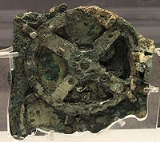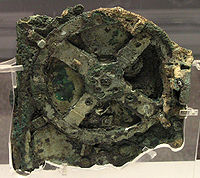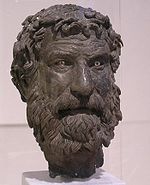
Antikythera wreck
Encyclopedia
The Antikythera wreck is a shipwreck
from the 1st or 2nd century BC. It was discovered by sponge divers
off Point Glyphadia on the Greek
island Antikythera
in the early 1900s. The wreck produced numerous statues dating back to the 4th century BC, as well as the world's oldest known analog computer
, the Antikythera mechanism
.
on the island of Antikythera
, and they began diving for sponge
s off the island's coastline. In 1900, divers usually wore standard diving dress
es — canvas
suits and copper
helmets — which allowed them to dive deeper and to stay submerged longer.
 The first to lay eyes on the shipwreck 60 meters down was Elias Stadiatos, who quickly signaled to be pulled to the surface. He described the scene as a heap of rotting corpses and horses lying on the sea bed. Thinking the diver had gone mad from too much carbon dioxide
The first to lay eyes on the shipwreck 60 meters down was Elias Stadiatos, who quickly signaled to be pulled to the surface. He described the scene as a heap of rotting corpses and horses lying on the sea bed. Thinking the diver had gone mad from too much carbon dioxide
in his helmet, Kondos himself dove into the water, soon returning with a bronze
arm of a statue. Until they could safely leave the island, the divers dislodged as many small artifacts as they could carry.
Together with the Greek Education Ministry and Hellenic Navy
, the sponge divers salvaged numerous artifacts from the waters. By the end of 1902, divers had recovered statues of a philosopher's head, a young boy, a discus
thrower, the bronze Antikythera Ephebe of ca. 340 BC (now in the National Archaeological Museum of Athens
), a Hercules
, a marble
bull and a bronze lyre
. Many other small and common artifacts were also found. On 17 May 1902, however, archaeologist Valerios Stais
made the most celebrated find. When examining the pieces that had been recovered in the National Archaeological Museum in Athens
, he noticed that one of the pieces of rock had a gear wheel embedded in it. It would soon be identified as the Antikythera mechanism
; originally thought to be one of the first forms of a mechanised clock
, it is now considered to be the world’s oldest known analog computer
. The death of several divers from decompression sickness
put an end to work at the site.
 Some scholars have speculated that the ship was carrying part of the loot of the Roman General Sulla from Athens
Some scholars have speculated that the ship was carrying part of the loot of the Roman General Sulla from Athens
in 86 BC, and might have been on its way to Italy
. A reference by the Greek writer, Lucian
, to one of Sulla's ships sinking in the Antikythera region gave rise to this theory. Supporting an early 1st century BC date were domestic utensils and objects from the ship, similar to those known from other 1st century BC contexts. The amphora
s recovered from the wreck indicated a date of 80–70 BC, the Hellenistic pottery a date of 75–50 BC, and the Roman ceramics were similar to known mid 1st century types. Coins as yet unpublished discovered in the 1970s during work by Jacques Cousteau and associates confirm a date in the late 80s BC.
Remains of hull planks showed that the ship was made of elm
, a wood often used by the Romans
in their ships. Eventually in 1964 a sample of the hull planking was carbon dated, and delivered a calibrated calendar date of 220 BC ± 43 years. The disparity in the calibrated radiocarbon date and the expected date based on the ceramics was explained by the sample plank originating from an old tree cut much earlier than the ship's sinking event.
Further evidence for an early 1st century BC sinking date came in 1974, when Yale University Professor Derek de Solla Price
published his interpretation of the Antikythera mechanism
. He argued convincingly that the object was a calendar computer. From gear settings and inscriptions on the mechanism's faces, he concluded that the mechanism was made about 87 BC and lost only a few years later.
Shipwreck
A shipwreck is what remains of a ship that has wrecked, either sunk or beached. Whatever the cause, a sunken ship or a wrecked ship is a physical example of the event: this explains why the two concepts are often overlapping in English....
from the 1st or 2nd century BC. It was discovered by sponge divers
Sponge diving
Sponge diving is the oldest known form of the original art of underwater diving, in order to retrieve natural sponges for human use.-Background:...
off Point Glyphadia on the Greek
Greece
Greece , officially the Hellenic Republic , and historically Hellas or the Republic of Greece in English, is a country in southeastern Europe....
island Antikythera
Antikythera
Antikythera or Anticythera is a Greek island lying on the edge of the Aegean Sea, between Crete and Peloponnese. Since the 2011 local government reform it is part of the municipality of Kythira island....
in the early 1900s. The wreck produced numerous statues dating back to the 4th century BC, as well as the world's oldest known analog computer
Analog computer
An analog computer is a form of computer that uses the continuously-changeable aspects of physical phenomena such as electrical, mechanical, or hydraulic quantities to model the problem being solved...
, the Antikythera mechanism
Antikythera mechanism
The Antikythera mechanism is an ancient mechanical computer designed to calculate astronomical positions. It was recovered in 1900–1901 from the Antikythera wreck. Its significance and complexity were not understood until decades later. Its time of construction is now estimated between 150 and 100...
.
Discovery and artifact recovery
In October 1900, a team of sponge divers led by Captain Dimitrios Kondos had decided to wait out a severe storm hampering their sail back from AfricaAfrica
Africa is the world's second largest and second most populous continent, after Asia. At about 30.2 million km² including adjacent islands, it covers 6% of the Earth's total surface area and 20.4% of the total land area...
on the island of Antikythera
Antikythera
Antikythera or Anticythera is a Greek island lying on the edge of the Aegean Sea, between Crete and Peloponnese. Since the 2011 local government reform it is part of the municipality of Kythira island....
, and they began diving for sponge
Sea sponge
Sponges are animals of the phylum Porifera . Their bodies consist of jelly-like mesohyl sandwiched between two thin layers of cells. While all animals have unspecialized cells that can transform into specialized cells, sponges are unique in having some specialized cells, but can also have...
s off the island's coastline. In 1900, divers usually wore standard diving dress
Standard diving dress
A standard diving dress consists of a metallic diving helmet, an airline or hose from a surface supplied diving air pump, a canvas diving suit, diving knife and boots...
es — canvas
Canvas
Canvas is an extremely heavy-duty plain-woven fabric used for making sails, tents, marquees, backpacks, and other items for which sturdiness is required. It is also popularly used by artists as a painting surface, typically stretched across a wooden frame...
suits and copper
Copper
Copper is a chemical element with the symbol Cu and atomic number 29. It is a ductile metal with very high thermal and electrical conductivity. Pure copper is soft and malleable; an exposed surface has a reddish-orange tarnish...
helmets — which allowed them to dive deeper and to stay submerged longer.

Carbon dioxide
Carbon dioxide is a naturally occurring chemical compound composed of two oxygen atoms covalently bonded to a single carbon atom...
in his helmet, Kondos himself dove into the water, soon returning with a bronze
Bronze
Bronze is a metal alloy consisting primarily of copper, usually with tin as the main additive. It is hard and brittle, and it was particularly significant in antiquity, so much so that the Bronze Age was named after the metal...
arm of a statue. Until they could safely leave the island, the divers dislodged as many small artifacts as they could carry.
Together with the Greek Education Ministry and Hellenic Navy
Hellenic Navy
The Hellenic Navy is the naval force of Greece, part of the Greek Armed Forces. The modern Greek navy has its roots in the naval forces of various Aegean Islands, which fought in the Greek War of Independence...
, the sponge divers salvaged numerous artifacts from the waters. By the end of 1902, divers had recovered statues of a philosopher's head, a young boy, a discus
Discus
Discus, "disk" in Latin, may refer to:* Discus , a progressive rock band from Indonesia* Discus , a fictional character from the Marvel Comics Universe and enemy of Luke Cage* Discus , a freshwater fish popular with aquarium keepers...
thrower, the bronze Antikythera Ephebe of ca. 340 BC (now in the National Archaeological Museum of Athens
National Archaeological Museum of Athens
The National Archaeological Museum in Athens houses some of the most important artifacts from a variety of archaeological locations around Greece from prehistory to late antiquity. It is considered one of the great museums in the world and contains the richest collection of artifacts from Greek...
), a Hercules
Hercules
Hercules is the Roman name for Greek demigod Heracles, son of Zeus , and the mortal Alcmene...
, a marble
Marble
Marble is a metamorphic rock composed of recrystallized carbonate minerals, most commonly calcite or dolomite.Geologists use the term "marble" to refer to metamorphosed limestone; however stonemasons use the term more broadly to encompass unmetamorphosed limestone.Marble is commonly used for...
bull and a bronze lyre
Lyre
The lyre is a stringed musical instrument known for its use in Greek classical antiquity and later. The word comes from the Greek "λύρα" and the earliest reference to the word is the Mycenaean Greek ru-ra-ta-e, meaning "lyrists", written in Linear B syllabic script...
. Many other small and common artifacts were also found. On 17 May 1902, however, archaeologist Valerios Stais
Valerios Stais
Valerios Stais was a Greek archaeologist. He was born in Kythera. He studied medicine and later archaeology. He became the director of the National Archaeological Museum of Athens in 1887 and held that post until his death. During that period he organized or participated in excavations in...
made the most celebrated find. When examining the pieces that had been recovered in the National Archaeological Museum in Athens
Athens
Athens , is the capital and largest city of Greece. Athens dominates the Attica region and is one of the world's oldest cities, as its recorded history spans around 3,400 years. Classical Athens was a powerful city-state...
, he noticed that one of the pieces of rock had a gear wheel embedded in it. It would soon be identified as the Antikythera mechanism
Antikythera mechanism
The Antikythera mechanism is an ancient mechanical computer designed to calculate astronomical positions. It was recovered in 1900–1901 from the Antikythera wreck. Its significance and complexity were not understood until decades later. Its time of construction is now estimated between 150 and 100...
; originally thought to be one of the first forms of a mechanised clock
Clock
A clock is an instrument used to indicate, keep, and co-ordinate time. The word clock is derived ultimately from the Celtic words clagan and clocca meaning "bell". A silent instrument missing such a mechanism has traditionally been known as a timepiece...
, it is now considered to be the world’s oldest known analog computer
Analog computer
An analog computer is a form of computer that uses the continuously-changeable aspects of physical phenomena such as electrical, mechanical, or hydraulic quantities to model the problem being solved...
. The death of several divers from decompression sickness
Decompression sickness
Decompression sickness describes a condition arising from dissolved gases coming out of solution into bubbles inside the body on depressurization...
put an end to work at the site.
Dating the ship
Although the retrieval of artifacts from the shipwreck was highly successful and accomplished in two years, dating the site proved difficult and took much longer. Based on related works with known provenances, some of the bronze statues dated back to the 4th century BC, while the marble statues were found to be 1st century BC copies of earlier works.
Athens
Athens , is the capital and largest city of Greece. Athens dominates the Attica region and is one of the world's oldest cities, as its recorded history spans around 3,400 years. Classical Athens was a powerful city-state...
in 86 BC, and might have been on its way to Italy
Italy
Italy , officially the Italian Republic languages]] under the European Charter for Regional or Minority Languages. In each of these, Italy's official name is as follows:;;;;;;;;), is a unitary parliamentary republic in South-Central Europe. To the north it borders France, Switzerland, Austria and...
. A reference by the Greek writer, Lucian
Lucian
Lucian of Samosata was a rhetorician and satirist who wrote in the Greek language. He is noted for his witty and scoffing nature.His ethnicity is disputed and is attributed as Assyrian according to Frye and Parpola, and Syrian according to Joseph....
, to one of Sulla's ships sinking in the Antikythera region gave rise to this theory. Supporting an early 1st century BC date were domestic utensils and objects from the ship, similar to those known from other 1st century BC contexts. The amphora
Amphora
An amphora is a type of vase-shaped, usually ceramic container with two handles and a long neck narrower than the body...
s recovered from the wreck indicated a date of 80–70 BC, the Hellenistic pottery a date of 75–50 BC, and the Roman ceramics were similar to known mid 1st century types. Coins as yet unpublished discovered in the 1970s during work by Jacques Cousteau and associates confirm a date in the late 80s BC.
Remains of hull planks showed that the ship was made of elm
Elm
Elms are deciduous and semi-deciduous trees comprising the genus Ulmus in the plant family Ulmaceae. The dozens of species are found in temperate and tropical-montane regions of North America and Eurasia, ranging southward into Indonesia. Elms are components of many kinds of natural forests...
, a wood often used by the Romans
Ancient Rome
Ancient Rome was a thriving civilization that grew on the Italian Peninsula as early as the 8th century BC. Located along the Mediterranean Sea and centered on the city of Rome, it expanded to one of the largest empires in the ancient world....
in their ships. Eventually in 1964 a sample of the hull planking was carbon dated, and delivered a calibrated calendar date of 220 BC ± 43 years. The disparity in the calibrated radiocarbon date and the expected date based on the ceramics was explained by the sample plank originating from an old tree cut much earlier than the ship's sinking event.
Further evidence for an early 1st century BC sinking date came in 1974, when Yale University Professor Derek de Solla Price
Derek J. de Solla Price
Derek John de Solla Price was a physicist, historian of science, and information scientist,credited as the father of scientometrics.-Biography:...
published his interpretation of the Antikythera mechanism
Antikythera mechanism
The Antikythera mechanism is an ancient mechanical computer designed to calculate astronomical positions. It was recovered in 1900–1901 from the Antikythera wreck. Its significance and complexity were not understood until decades later. Its time of construction is now estimated between 150 and 100...
. He argued convincingly that the object was a calendar computer. From gear settings and inscriptions on the mechanism's faces, he concluded that the mechanism was made about 87 BC and lost only a few years later.
Sources
- P. Kabbadias, The Recent Finds off Cythera The Journal of Hellenic StudiesJournal of Hellenic StudiesThe Journal of Hellenic Studies is a peer-reviewed academic journal which contains articles that pertain to Hellenic studies, i.e. the language, literature, history, and archaeology of the ancient Greek world, and reviews of recent books of importance to Hellenic studies. It is published annually...
, Vol. 21. (1901), pp. 205–208. - Gladys Davidson Weinberg; Virginia R. Grace; G. Roger Edwards; Henry S. Robinson; Peter Throckmorton; Elizabeth K. Ralph, "The Antikythera Shipwreck Reconsidered", Transactions of the American Philosophical Society, New Ser., Vol. 55, No. 3. (1965), pp. 3–48.
- Derek de Solla Price, "Gears from the Greeks. The Antikythera Mechanism: A Calendar Computer from ca. 80 B. C." Transactions of the American Philosophical Society, New Ser., Vol. 64, No. 7. (1974), pp. 1–70.
- Nigel Pickford, The Atlas of Ship Wrecks & Treasures, p 13–15, ISBN 0-86438-615-X.
- Willard BascomWillard BascomWillard Bascom , was an engineer and scientist, who first proposed using Neoprene for wetsuits to fellow scientist Hugh Bradner. He also proposed the hypothesis that anoxic water in the Black Sea could have preserved ancient Black Sea shipwrecks...
, Deep water, ancient ships: The treasure vault of the Mediterranean, ISBN 0-7153-7305-6.

